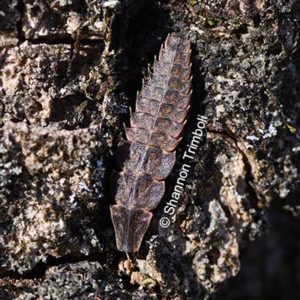I used to think that there was only one type of firefly. I think many of us go through that stage. Looking back, I have to laugh because why would there only be one type of firefly? I mean, we have more than one type of bird, butterfly, frog, fish, etc. Why should fireflies be any different?
There are many, many different species of fireflies in the eastern U.S. and new species are still being recognized. Different species of fireflies will often display at different times of the year. The spring treetop flasher (Pyractomena borealis) is the first firefly to start displaying in much of the eastern U.S. In fact, this may be one of the easiest fireflies to identify to species because it is active so much earlier than other firefly species in this region.

Life History of the Spring Treetop Flasher
The spring treetop flasher can be found throughout most of the eastern U.S. and parts of Canada. Details about the early larval stages are not well known. In the late winter or early spring, the larva will crawl up the trunk of a tree to pupate. The larva will find a furrow in the bark on the south side of the tree, then attach itself so that it is hanging face down to pupate. The pupal stage lasts several weeks, during which time it can undergo wide swings in temperature and other weather conditions. They are found most often on tulip poplars and hickories.
When firefly pupae first eclose or emerge as adults, they are bright white. It may take up to 24 hours for their exoskeleton to fully harden and darken into what we would recognize as the familiar firefly coloration. Male spring treetop flashers eclose a week or two before the females. If a male can find a female pupa, then it will often wait nearby for her to eclose. During this time, he will not flash and will fight with any other males that come near. When the female finally ecloses, any males that were waiting nearby will try to mate with her immediately without waiting for her exoskeleton to fully harden. Females head to the tops of the trees as soon as their exoskeletons have hardened and the males follow when they can’t find any more female pupae.
Spring treetop flashers are our earliest fireflies to begin flashing. They will display while flying near bare tree branches or branches that have just recently leafed out. However, they can only display on nights that are relatively warm with no precipitation and calm winds. Since they are active so early in the spring, many of the nights during their breeding season aren’t conducive to flashing which is why males try to mate with females as soon as they eclose. Both males and females will mate multiple times. The adults only live for about a month and don’t eat during that time, instead they focus all of their energy on mating and laying eggs.
When and Where to Look for Them
Larva and pupa
Look for larval and pupal spring treetop flashers on the south-facing side of tulip polar and hickory trees in late winter as the temperatures first start to warm up. They’ll usually be in the furrows. If you find a larva or pupa, don’t disturb it. Next year, check the same tree, because the odds are really good that you’ll find new pupa and larva there.
Adults
If you find a larval or pupal spring treetop flasher and it is possible, then go back and check on it every few days towards late March or early April (maybe a little later depending on how far north you are). If your pupa happens to be a female, then you may find one or more adult males guarding or fighting for her. Again, don’t disturb them if you see the adult males or get lucky enough to find an adult female.
Shortly before, or just as the leaves are starting to emerge, begin watching the tops of the trees on nights that have good weather (little to no wind and no precipitation) and are at least 50 degrees Fahrenheit. Displaying spring treetop flashers produce a yellow flash every couple of seconds or so. According to the book Fireflies, Glow-worms, and Lightning Bugs *, spring treetop flashers typically display from about 45 minutes after sunset until about 90 minutes after sunset.
Summary
We may think of fireflies as being mainly summer insects, but that’s not entirely true. Summer is when we see our highest diversity of firefly species, but the spring treetop flasher displays on warm spring nights. It can be fun to look for their larvae and pupae on the sides of trees in the late winter and very early spring. Then as the weather warms up a little more, the adult spring treetop flashers begin to flash their courtship displays among the tree leaves that are just beginning to appear. If you love watching fireflies in the summer, then looking for the spring treetop flashers is a great way to extend your firefly watching season.
* Amazon links are affiliate links and I earn a small commission from qualifying Amazon purchases made the link. The commission is paid by Amazon and comes at no extra cost to you, but helps support the costs associated with hosting the Backyard Ecology blog, podcast, and website.

Backyard Ecology: Exploring Nature in Your Backyard
Nature isn’t just “out there.” It’s all around us, including right outside our doors. Hi, my name is Shannon Trimboli, and I am the host of Backyard Ecology. I live in southcentral Kentucky and am a wildlife biologist, educator, author, beekeeper, and owner of a nursery specializing in plants for pollinators and wildlife conservation. I invite you to join me as we ignite our curiosity and natural wonder, explore our yards and communities, and improve our local pollinator and wildlife habitat. Learn more or subscribe to my email list at www.backyardecology.net.

Leave a Reply